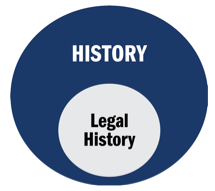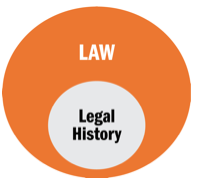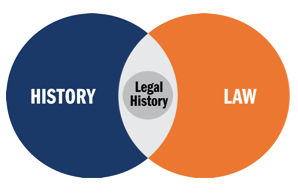After reading “Four Fragments,” I returned to the journal I kept as a requirement of Dirk’s course. There, in the very first entry dated February 6, 1998, I had memorialized that first encounter with Hurst.
-Risa L. Goluboff
There is something very meta about an article in which Hartog reflects on Hurst reflecting on Holmes as part of an exploration of legal history and its larger intellectual and institutional contexts. There is something even more meta about a blog post in which Goluboff reflects on Hartog reflecting on Hurst reflecting on Holmes. As I read Dirk’s wonderful, rich, and probing essay, I kept picturing these nested analyses as a kind of flow chart:

Drawing these arrows in the margins, I was struck that “flow chart” was less apt than “timeline.” However meta it might initially seem, there is something quite concrete about the progression—a generational baton passing of fundamental questions about the relationship(s) between law and history.
This combination of nested analytical flow chart and (auto)biographical timeline offers numerous entry points for a short blog post like this one. Leaving Holmes for another day, I have focused my reflections on my own views of Hurst, why they differ from Hartog’s, and how they relate to my views of legal history, and the relationship of those views to Hartog’s. (Hence my turn to assistance from a flow chart and three Venn diagrams.) To foreground my conclusions: Many of the insights for which Dirk credits Hurst more appropriately, in my view, belong to Dirk. And those insights—Dirk’s own insights—provide answers to more of Dirk’s questions than he suggests.
That Dirk takes Hurst as one of his entry points for understanding modern American legal history makes eminent sense on two levels. First, as Dirk says, Hurst is “the founder of the modern discipline of legal history.”[1] Second, as Dirk also says, Hurst played a formative role in Dirk’s own intellectual development. (More on that below.)
Dirk’s assessment of Hurst is self-consciously ambivalent. The Hurst of Fragment Two (and to a lesser extent Fragment Four) is deeply flawed. Hurst is a consensus historian who elides and excludes so many Americans—and so many of the subjects of Dirk’s own work—from his undertheorized and unperiodized “we.” Yet in Fragment Three, Dirk attempts to reconcile with Hurst, indeed to resurrect him. His question is “What is left of Hurst’s legal history?” His answer—“Actually, a lot.”[2]—finds much of Hurst in the legal history in which he understands himself, and all of “us” self-described legal historians, engaged.
For my part, the flawed Hurst of Fragment Two is by far the more salient. That has always been the case. I first read Hurst at Dirk’s proverbial knee as a graduate student in 1998. After reading “Four Fragments,” I returned to the journal I kept as a requirement of Dirk’s course. There, in the very first entry dated February 6, 1998, I had memorialized that first encounter with Hurst. Not only did I then, as I do now, find problematic the exclusion of so many from Hurst’s “we.” I also found (and find) the lack of conflict and coercion, the absence of humanity and Hartogian “mess,” both sterile and underwhelming.
I have always taken my lack of appreciation for Hurst largely as my failing, and I am almost embarrassed to put it in (digital) print. Not only do I know the foundational role Hurst played in modern legal history, but any transitive property inherent in my flow chart/timeline should mean that Dirk’s appreciation for Hurst should flow to me.
My guess is that some of my response to Hurst resembles my response to the classic film “Casablanca”: by the time I saw “Casablanca” in college, it had so permeated popular culture that it seemed to be all cliché. Perhaps Hurst’s influence on legal history has been so profound and fundamental, has so infused the affirmative case for and the contours of professional legal history, that Hurst’s own writing has lost much of what originally made it so compelling. My lack of appreciation for Hurst, then, is no doubt shaped by my location in the history of legal history as a field.
It is also, no doubt, shaped by my location in my (auto)biographical flow chart/timeline. Dirk is my giant as Hurst was Dirk’s. (Hence the fact that I refer here to Hurst as Hurst and Hartog as Dirk.) To me, Dirk’s legal history is everything Hurst’s is not: human and inclusive and messy and full of conflict. It takes “seriously the contingent and unsettled history of the instantiations of ‘law’ as law,” “of the contradictions and the multiplicities” of legal objects. At points in Fragments Three and Four, Dirk ascribes many such insights to Hurst in one way or another. But I can’t find them there. To me, they are not Hurst. They are essentially Hartog.
Which brings me to the Venn diagrams. Where Dirk and I differ over how to read Hurst is inextricable from the changing institutional and intellectual contexts within which we each encountered our respective giants. For Dirk and his few contemporaries in the 1970s, becoming a legal historian in a law school meant in large part creating that role themselves. Their position in the law school intellectual landscape was a somewhat liminal one. They found themselves frequently having to answer questions about where the legal historian, and legal history itself, belongs. “Law” and “history” were separate endeavors, which required “legal history” to continually justify itself and its place. Fragment One thus asks separately about the relationship of legal history to the practice of history more broadly[3] (Diagram 1) and about the relationship of legal history to law[4](Diagram 2). “History” and “law” are the overarching endeavors, and Dirk wants to understand where “legal history” sits in relation to each, separate, one.


My generation, by contrast, has taken for granted legal history’s fairly (though not entirely) comfortable place within the law school academic landscape. During my joint degree days, there was a whole cohort of us, moving through law school and graduate school together. It generally seemed we would find jobs in law schools, and that we would generally be welcomed. It is not that we never encountered colleagues who wondered about the need for legal historians within law schools or the relevance of legal history to law practice. Such critiques, as well as the general hydraulic pressures of a professional school setting often preoccupied with the normative implications of legal scholarship, must, according to Dirk, push legal historians toward a more practical and normative legal history. This would account, as he suggests, for the presentism one finds within legal history, the preoccupation with lost origins, the claim that legal history not only informs about the past but opens up the legal imagination for the present and the future.[5]
As to those instincts within my own scholarship, guilty as charged. But I am not sure Dirk has the causal relationship quite right. As much as I agree that my institutional context has affected my legal history, I am equally sure that I chose that institutional context at least in part because of how I wanted to approach the field and my work in it. Though the greater normativity of legal history in law schools brings with it disciplinary perils to which the professional historian must attend, it nonetheless seems to me a feature not a bug, as the economists would put it (use of that phrase itself proof I’m sure to Dirk of my spending far too long in a law school).
All of this is to say that I either do not feel the tension Dirk does or I reject the dichotomy he sees between “how to characterize and present the law that was there, in that situation” and the “presentist or legally salient reasons” a particular historical moment might be important.[6] I do not think of those as irreconcilable.
More significantly, and returning the flow chart/timeline, I attribute my comfort with this methodological messiness to Dirk, just as he attributes aspects of his own writing to Hurst. So too do I attribute to Dirk (perhaps to his chagrin) my understanding of the possibilities of legal historical work in law schools. At the end of “Four Fragments,” Dirk suggests that “one task for legal history … should be, I suspect, to find a balance between law as universalizing and hegemonic and law as a space for conflict and as an arena for disparate and distinctive worldviews and understandings.”[7] Though Dirk offers this aspiration up with characteristic humility (“I suspect”), it is exactly what I have always taken from his work and his gentle direction. Dirk simultaneously explores the past as it was and raises the most fundamental of jurisprudential questions, his work is deeply contingent and yet offers fodder for both methodological and legal normativity in ways that belong in both law schools and in history departments. He ranges from “pigs” to “positivism” and everywhere in between.[8]
In other words, it is Dirk who has enabled me (and my generation and beyond?) to visualize the relationship between legal history, history, and law as integrated rather than separate: as in Diagram 3.

I might not be as comfortable in the historical mess as Dirk, but I am at home in the methodological and institutional mess inherent in this final diagram. That has nothing to do with Hurst. And everything to do with Hartog.
[1] Hendrik Hartog, “Four Fragments on Doing Legal History, or Thinking with and against William Hurst,” Law and History Review 39, no. 4 (2021), 835.
[2] Hartog, “Four Fragments,” 853.
[3] Ibid, 838.
[4] Ibid, 840.
[5] Ibid, 838-839.
[6] Ibid, 856.
[7] Ibid, 865.
[8] See, Hendrik Hartog, “Pigs and Positivism,” Wisconsin Law Review 1985 (1985), 899-935.


 She is the author of two award-winning books:
She is the author of two award-winning books: